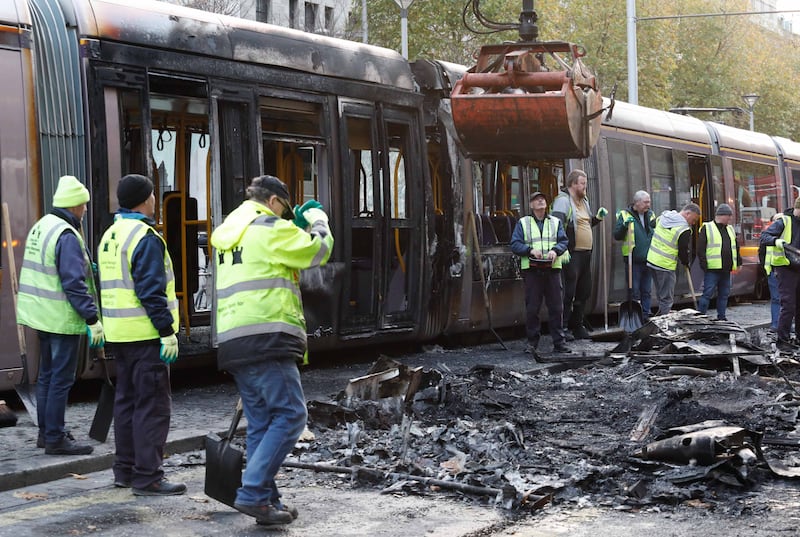The reintroduction 20 years ago of trams to the streets of Dublin after a 45-year hiatus was seen at the time as faddish or, worse still, folly.
Respected economists and transport commentators said the new trams would not meet passenger targets, would be “grossly uneconomic” and would probably aggravate, rather than reduce, city congestion by obstructing motorists.
Luas started operating on the Green line from June 30th, 2004 with the Red line following in September. It was an immediate success.
In its first year, it broke through its 20 million passengers target by carrying 22 million. Unlike all other public transport services, it required no State subvention, and as for congestion, the culprits were largely single-occupancy vehicles blocking trams carrying hundreds or passengers, not the other way around.
READ MORE
One year after operations started, it was formally acknowledged that the real folly had been to build two separate tram lines, with the Government announcing in 2005 they were to be connected.
Plans for the return of trams, following the closure of the last line to Howth Head in 1959, had been put forward in the early 1980s, though it was the mid-1990s before legislation was enacted to facilitate their return. Originally there was to be a continuous line from Tallaght to Dundrum running through the city centre, with a later link-up through Ballymun.
After many years, and a public inquiry, it was decided at the end of the 1990s to go for a line from Tallaght to Connolly and a second line from Dublin Airport to Sandyford.
However, before construction began, it was decided to cut the Sandyford line at St Stephens Green and serve the airport with a future underground, leaving the Red and Green lines isolated, and the city centre unserved by trams until the Green line extension from St Stephen’s Green to Broombridge opened in 2017.
“There was an awful lot of scepticism of the system back then and there was bit of revisionism once it opened and was so popular with the public,” says Anthony Duffy, head of project services with Transport Infrastructure Ireland (TII), the State agency in charge of public transport infrastructure.
Duffy, who worked for Irish Rail at the time, said there was quite a degree of scorn in the general transport sector at the idea of reintroducing a system considered outmoded in the 1950s.
“Everyone I was talking to thought it was not a good idea. Sentiment was very negative, so I don’t think there was that much surprise at the time that it wasn’t going to be joined up. It was only when it became so popular that people started complaining it hadn’t been done in the first place,” he says.
Paul Balmer, who drove the first tram for the ribbon-cutting ceremony in June 2004 (as regular repeats of RTÉ’s Reeling in the Years remind him), said the instant success of the service was astonishing.
“In the first few days we were having to get people to queue at St Stephen’s Green to get on,” he says. “It probably helped that it was free,” he concedes, “but even in the weeks after, big numbers kept coming”.
The arrival of the Luas also astonished motorists.
“I remember one day at Heuston, when the Red line started there was a car in the yellow box and we were all going nowhere, so I went over to talk to the gentleman and told him he was in the yellow box and he said: ‘Yeah, but I’m from Wexford’,” says Balmer, qualifying that this is not a slight on Wexford people.
“I sort of knew where he was coming from. He obviously knew about yellow boxes, but when it is another car you have blocked you can get out of each other’s way quick enough, but when it is a tram stretching back 40m, people can be like deer in the headlights.”
The passing decades since the last tram was on the streets, coupled with the huge increase in cars since then, was always going to cause teething problems for the new service, according to Luas director of operations Dave Rooney.
“There was a 45-year gap between the last tram that operated in the city and our one, and all that knowledge was obviously gone, so there was a huge piece of educating the public that the tram is now operating on the street,” he says.
The service is far from collision-free, but incidents have diminished, Rooney says, with last year recording a lower level of collisions than in the first full year of operations.
“Considering we are running twice as much track as we did back then, that’s an achievement,” he says.
It’s also a testament to the training and ability of the drivers, says Balmer, who now oversees driver training.
“A lot of time is spent teaching defensive driving techniques. This is where you expect the unexpected to happen, though we can’t put them in the mind of the other road users and obviously they can’t swerve out of the way.”
This is where the use of camera-based enforcement could make a substantial difference. Traffic light cameras, which take pictures of motorists if they break a red light, were installed for a six-month trial at the junction of Blackhall Place and the Red line in Dublin’s north inner city in 2015.
They were hugely successful with more than 800 motorists prosecuted, but crucially the number of drivers breaking lights halved in the second three months of the trial.
Following their success in improving road safety, they were removed. Minister for Transport Eamon Ryan in April said new cameras would be introduced from early next year.
Traffic headaches aside, driving trams is “a pleasure and a privilege”, Balmer says.
“My family are from Broadstone, my grandfather worked across the road from us when it was the CIE depot, so to have a similar job, it’s quite emotional for me.”
This, Balmer says, made last November’s Dublin riots – when a Luas tram was set on fire on a night of violence incited by far-right agitators – all the more difficult to take.
“It was actually my birthday,” he says. “To be honest with you, when the tram went on fire it was quite upsetting to see that happen. To see people damaging their own city for all the wrong reasons – that was very, very unpleasant.”

As soon as it became apparent the scenes in the city were more than just an isolated skirmish, tram drivers were directed out of the centre, but one tram on O’Connell Street became trapped from both sides.
“We could see [in the control room] what was happening, so we were able to say to the driver ‘lock up your tram, remove your high vis [jacket] so you don’t become a target, and walk away’.”
[ Love on the Luas: Tracking romances on Dublin’s tram systemOpens in new window ]
After gardaí and fire services brought the city under control attention turned to restoring services, Rooney says.
“I was with Paul, and had the same feeling of almost grief seeing the tram go on fire; it was very upsetting to see,” he says.
“But then seeing the resilience of the staff, working with the council and the emergency services, getting back up and going for full service on Saturday morning, just over 24 hours later – it was incredible.”
While the riots were an outlier in terms of criminal attacks on the public transport, the Luas isn’t immune from the sort of antisocial incidents that can blight transport services and deter people from switching from their cars.
Complaints of antisocial behaviour reached their highest level in a decade last year and more than doubled from the previous year, to 2,159.
Both Rooney and Duffy say the increase in complaints, while not taken lightly either by operator Transdev or TII, coincided with the introduction of new ways for passengers to report incidents or concerns on the tram, including direct messaging services.
It also comes at a time of increasing growth in users, Rooney says, with passenger numbers set to hit 50 million this year.
“We carry the second biggest number of passenger journeys on the island of Ireland, just after Dublin Bus, and bigger than all of Irish Rail combined,” he says.
“A Green line tram can take just short of 400 people, and in the morning they are travelling into the city about 2½ minutes apart – that’s the equivalent of the 747 jumbo jet arriving in St Stephens Green every 2½ minutes.”
- Sign up for push alerts and have the best news, analysis and comment delivered directly to your phone
- Join The Irish Times on WhatsApp and stay up to date
- Listen to our Inside Politics podcast for the best political chat and analysis

















